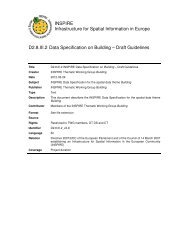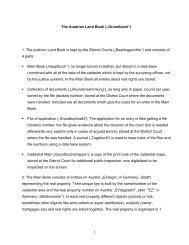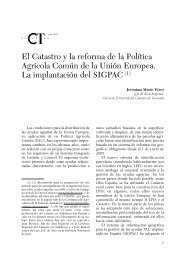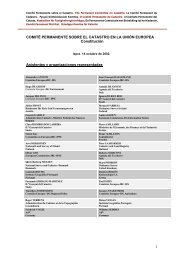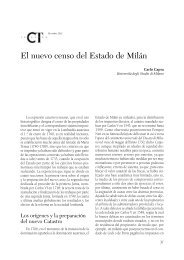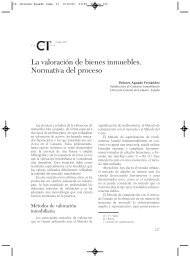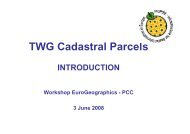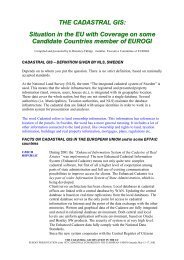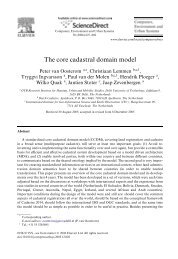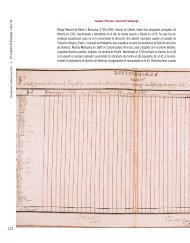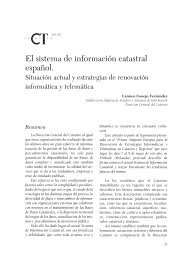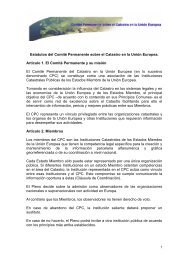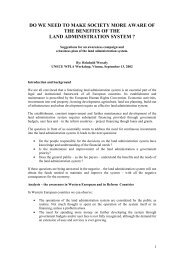01.I Congress on Cadastre - Permanent Committee on Cadastre in ...
01.I Congress on Cadastre - Permanent Committee on Cadastre in ...
01.I Congress on Cadastre - Permanent Committee on Cadastre in ...
You also want an ePaper? Increase the reach of your titles
YUMPU automatically turns print PDFs into web optimized ePapers that Google loves.
<str<strong>on</strong>g>01.I</str<strong>on</strong>g> <str<strong>on</strong>g>C<strong>on</strong>gress</str<strong>on</strong>g> <strong>on</strong> <strong>Cadastre</strong> 9/12/02 20:20 Pág<strong>in</strong>a 207<br />
be punctually handed over to the Lat<strong>in</strong> American Cadastral<br />
Heads and so they were able to use the knowledge to be<br />
exposed <strong>in</strong> this forum <strong>in</strong> the way they should like. I could<br />
not bear <strong>in</strong> m<strong>in</strong>d any other better c<strong>on</strong>tent to start with the<br />
activities of the «Lat<strong>in</strong> american Cadastral Forum» that will<br />
be announced <strong>in</strong> the com<strong>in</strong>g days by the Directorate<br />
General of the <strong>Cadastre</strong> <strong>on</strong> the Web site of our M<strong>in</strong>istry to<br />
be used by all the c<strong>on</strong>cerned. In do<strong>in</strong>g so I hope there will<br />
be a much more solid and last<strong>in</strong>g l<strong>in</strong>ks <strong>in</strong> terms of<br />
usefulness between the two geographical areas.<br />
I s<strong>in</strong>cerely hope that the <str<strong>on</strong>g>C<strong>on</strong>gress</str<strong>on</strong>g> will resp<strong>on</strong>d to the<br />
expectati<strong>on</strong>s have been and I wish you to enjoy the stay at<br />
Spa<strong>in</strong> as well as at Granada.<br />
Thank you very much for your attenti<strong>on</strong>. ■<br />
Two <strong>in</strong>itiatives for the<br />
approximati<strong>on</strong> of the cadastres of<br />
member States: the «Declarati<strong>on</strong><br />
<strong>on</strong> <strong>Cadastre</strong> <strong>in</strong> the European<br />
Uni<strong>on</strong>» and the «cadastre<br />
permanent committee»*<br />
IGNACIO DURÁN BOO<br />
Directorate General for the <strong>Cadastre</strong>. Spa<strong>in</strong><br />
Despite the grow<strong>in</strong>g importance of exist<strong>in</strong>g cadastral<br />
systems <strong>in</strong> all EU member States and their c<strong>on</strong>stant usage<br />
for <strong>in</strong>numerable private and public needs, <strong>in</strong>clud<strong>in</strong>g those<br />
deriv<strong>in</strong>g from the applicati<strong>on</strong> of EU policies, the <strong>Cadastre</strong> is<br />
not a harm<strong>on</strong>ised activity. There is therefore no comm<strong>on</strong><br />
regulati<strong>on</strong> that describes the purpose, m<strong>in</strong>imum c<strong>on</strong>tent<br />
and functi<strong>on</strong>s that must be fulfilled by the <strong>Cadastre</strong> <strong>in</strong> each<br />
member State, <strong>in</strong> spite of the fact that the EU usually applies<br />
community funds to f<strong>in</strong>ance and support the creati<strong>on</strong> and<br />
development of this Instituti<strong>on</strong> <strong>in</strong> countries apply<strong>in</strong>g for<br />
membership, as part of the basic <strong>in</strong>stituti<strong>on</strong>al structure<br />
required for accessi<strong>on</strong> by candidate countries.<br />
Numerous <strong>in</strong>itiatives have been carried out <strong>in</strong> recent<br />
years to improve knowledge of cadastres <strong>in</strong> Europe. A<br />
relevant example is the important role played by the<br />
Work<strong>in</strong>g Party <strong>on</strong> Land Adm<strong>in</strong>istrati<strong>on</strong> (comm<strong>on</strong>ly known<br />
by its acr<strong>on</strong>ym WPLA), created with<strong>in</strong> the United Nati<strong>on</strong>s’<br />
Ec<strong>on</strong>omic Commissi<strong>on</strong> for Europe, which is mak<strong>in</strong>g<br />
significant c<strong>on</strong>tributi<strong>on</strong>s; another example is the activity of<br />
EUROGEOGRAPHICS, an organisati<strong>on</strong> formed by Europe’s<br />
nati<strong>on</strong>al geographic <strong>in</strong>stitutes. However, until now, no<br />
* While this number of the magaz<strong>in</strong>e was pr<strong>in</strong>t<strong>in</strong>g, <strong>on</strong><br />
October 14 th <strong>in</strong> the headquarters of the Comm<strong>on</strong> Investigati<strong>on</strong><br />
Centre of the European Uni<strong>on</strong> <strong>in</strong> Ispra (Italy) it took place the<br />
first meet<strong>in</strong>g ot the «<strong>Permanent</strong> <strong>Committee</strong> <strong>on</strong> <strong>Cadastre</strong> <strong>in</strong> the<br />
European Uni<strong>on</strong>», with the participati<strong>on</strong> of the 15 member<br />
countries.<br />
TWO INITIATIVES FOR THE APPROXIMATION OF THE CADASTRES OF MEMBER STATES<br />
<strong>in</strong>itiative had directly focused <strong>on</strong> the <strong>Cadastre</strong> exclusively<br />
from the perspective of the totality of member States and<br />
its applicati<strong>on</strong> to the policies developed by the Uni<strong>on</strong>.<br />
Address<strong>in</strong>g this need, the Spanish Government’s Official<br />
Performance Programme of the Spanish Presidency of the<br />
EU Council (<strong>in</strong> the first semester of 2002) <strong>in</strong>cluded the<br />
<strong>in</strong>itiative proposed by the Spanish Directorate General for<br />
the <strong>Cadastre</strong> to hold the «First <str<strong>on</strong>g>C<strong>on</strong>gress</str<strong>on</strong>g> <strong>on</strong> <strong>Cadastre</strong> <strong>in</strong> the<br />
European Uni<strong>on</strong>». The ma<strong>in</strong> objective of the c<strong>on</strong>ference<br />
was to study the role that the <strong>Cadastre</strong> should play with<strong>in</strong><br />
the EU, and the formulas that could facilitate the<br />
approximati<strong>on</strong> of pre-exist<strong>in</strong>g nati<strong>on</strong>al models towards a<br />
system c<strong>on</strong>ta<strong>in</strong><strong>in</strong>g enough comm<strong>on</strong> elements to allow<br />
adequate coord<strong>in</strong>ati<strong>on</strong> between said models.<br />
In this scenario, the Spanish Directorate General fro the<br />
<strong>Cadastre</strong> presented, am<strong>on</strong>g other <strong>in</strong>terventi<strong>on</strong>s, two specific<br />
<strong>in</strong>itiatives to progress <strong>in</strong> the aim of coord<strong>in</strong>ati<strong>on</strong>: the project<br />
for a «Declarati<strong>on</strong> of the <strong>Cadastre</strong> <strong>in</strong> the European Uni<strong>on</strong>»,<br />
and the creati<strong>on</strong> of a <strong>Cadastre</strong> <strong>Permanent</strong> <strong>Committee</strong>. Both<br />
<strong>in</strong>itiatives are described <strong>in</strong> this Paper. But firstly it is relevant<br />
to review, al least <strong>in</strong> broad terms, the four groups of reas<strong>on</strong>s<br />
that led the Directorate General to propose these two<br />
<strong>in</strong>itiatives at this particular time:<br />
Technological reas<strong>on</strong>s<br />
All <strong>in</strong>stituti<strong>on</strong>s resp<strong>on</strong>sible for <strong>Cadastre</strong> <strong>in</strong> the member<br />
States now have computerised management systems. They<br />
all draw up maps <strong>in</strong> digital formats and update aggregate<br />
<strong>in</strong>formati<strong>on</strong> us<strong>in</strong>g similar technologies. This circumstance,<br />
together with the thoroughly researched standardis<strong>in</strong>g effect<br />
of digital technology, lead us to foresee the communicati<strong>on</strong><br />
and exchange of cadastral <strong>in</strong>formati<strong>on</strong> between member<br />
States <strong>in</strong> the near future, thus establish<strong>in</strong>g, <strong>in</strong> practical<br />
terms, de facto coord<strong>in</strong>ati<strong>on</strong>, the demand for which is<br />
grow<strong>in</strong>g due to the <strong>in</strong>creas<strong>in</strong>g use of territorial <strong>in</strong>formati<strong>on</strong><br />
by European citizens.<br />
On the other hand, the low cost of technology, lead<strong>in</strong>g<br />
to an <strong>in</strong>crease <strong>in</strong> the number of c<strong>on</strong>sumers of cadastral<br />
<strong>in</strong>formati<strong>on</strong>, together with the expansi<strong>on</strong> of communicati<strong>on</strong><br />
tools —such as XML language— that facilitate dialogue<br />
between equipment and sytems through Internet, are also<br />
important reas<strong>on</strong>s that recommend an attempt at<br />
coord<strong>in</strong>ati<strong>on</strong> at this time.<br />
Political reas<strong>on</strong>s<br />
The EU will so<strong>on</strong> undergo significant expansi<strong>on</strong>, both <strong>in</strong><br />
the number of States and <strong>in</strong> surface area. Thus, the Europe<br />
of 15 countries will become the Europe of 27, represent<strong>in</strong>g<br />
growth of the Uni<strong>on</strong>’s land surface by more than <strong>on</strong>e milli<strong>on</strong><br />
sixty five thousand square kilometres. This will foreseeably<br />
signify the <strong>in</strong>corporati<strong>on</strong> of several milli<strong>on</strong> parcels that will<br />
have to be <strong>in</strong>cluded <strong>in</strong> the Cadastral register.<br />
Obviously, if Cadastral coord<strong>in</strong>ati<strong>on</strong> is already difficult<br />
with 15 member States, it will be much more complicated<br />
after expansi<strong>on</strong> if we do not work now to def<strong>in</strong>e a comm<strong>on</strong><br />
Cadastral model.<br />
Regulatory reas<strong>on</strong>s<br />
There have recently been several European regulati<strong>on</strong>s<br />
<strong>in</strong> the form of Directives that <strong>in</strong>directly def<strong>in</strong>e and delimit<br />
cadastral activity. A real example of this is the projected<br />
Directive under preparati<strong>on</strong> by the Commissi<strong>on</strong>, through<br />
the Directorate General of the Informati<strong>on</strong> Society, to<br />
regulate the use by European citizens of <strong>in</strong>formati<strong>on</strong><br />
207
<str<strong>on</strong>g>01.I</str<strong>on</strong>g> <str<strong>on</strong>g>C<strong>on</strong>gress</str<strong>on</strong>g> <strong>on</strong> <strong>Cadastre</strong> 9/12/02 20:20 Pág<strong>in</strong>a 208<br />
1 ST CONGRESS ON CADASTRE IN THE EUROPEAN UNION<br />
c<strong>on</strong>ta<strong>in</strong>ed <strong>in</strong> public databases. This will directly affect<br />
cadastral systems <strong>in</strong> the member States given that the very<br />
essence of the <strong>Cadastre</strong> is to provide territorial <strong>in</strong>formati<strong>on</strong>.<br />
It is therefore advisable to establish the necessary levels<br />
of dialogue between cadastral adm<strong>in</strong>istrati<strong>on</strong> agencies and<br />
the various EU Directorates General resp<strong>on</strong>sible for<br />
prepar<strong>in</strong>g these Directives, <strong>in</strong> order to ensure that the latter<br />
have detailed knowledge of the c<strong>on</strong>tent and scope of<br />
cadastral activity <strong>in</strong> Europe.<br />
Reas<strong>on</strong>s deriv<strong>in</strong>g from the grow<strong>in</strong>g demand<br />
for cadastral <strong>in</strong>formati<strong>on</strong><br />
Without a doubt, this is the most powerful group of<br />
reas<strong>on</strong>s. The <strong>Cadastre</strong> is <strong>on</strong>ly good if the <strong>in</strong>formati<strong>on</strong> it<br />
c<strong>on</strong>ta<strong>in</strong>s is useful. Therefore the <strong>Cadastre</strong>s of the different<br />
member States must all be equally capable of resp<strong>on</strong>d<strong>in</strong>g to<br />
the needs of their respective citizens, so as not to place them<br />
at a disadvantage <strong>in</strong> comparis<strong>on</strong> with the citizens of other<br />
EU countries.<br />
The EU itself <strong>in</strong>creas<strong>in</strong>gly requires cadastral <strong>in</strong>formati<strong>on</strong><br />
to develop its policies. This is apparent <strong>in</strong> the c<strong>on</strong>structi<strong>on</strong><br />
of a s<strong>in</strong>gle European real estate market, a c<strong>on</strong>cept that is<br />
already a reality <strong>in</strong> Spa<strong>in</strong>, where nearly a milli<strong>on</strong> and a half<br />
properties are owned by foreigners, the majority EU<br />
citizens. In this envir<strong>on</strong>ment, the deregulati<strong>on</strong> of f<strong>in</strong>ancial<br />
markets would receive a genu<strong>in</strong>e boost from a system that<br />
provided access to the European mortgage market,<br />
<strong>in</strong>creas<strong>in</strong>g knowledge of the properties subject to this<br />
system of guarantees through the <strong>in</strong>formati<strong>on</strong> supplied by<br />
the <strong>Cadastre</strong>.<br />
The Uni<strong>on</strong> also needs the territorial <strong>in</strong>formati<strong>on</strong><br />
provided by the <strong>Cadastre</strong> to apply its Comm<strong>on</strong> Agricultural<br />
Policy and to implement active policies for envir<strong>on</strong>mental<br />
protecti<strong>on</strong>. A large part of these functi<strong>on</strong>s would benefit<br />
signficantly if their adm<strong>in</strong>istrators had access to parcel-level<br />
<strong>in</strong>formati<strong>on</strong> of the entire EU territory.<br />
The «Declarati<strong>on</strong> <strong>on</strong> <strong>Cadastre</strong> <strong>in</strong> the European Uni<strong>on</strong>»<br />
Dur<strong>in</strong>g the <str<strong>on</strong>g>C<strong>on</strong>gress</str<strong>on</strong>g> <strong>on</strong> <strong>Cadastre</strong> menti<strong>on</strong>ed above, the<br />
«Declarati<strong>on</strong> <strong>on</strong> <strong>Cadastre</strong> <strong>in</strong> the European Uni<strong>on</strong>» was presented<br />
as a project, with the aim of assembl<strong>in</strong>g <strong>in</strong> a s<strong>in</strong>gle document,<br />
with a programmatic character, the comm<strong>on</strong> elements that<br />
would allow the def<strong>in</strong>iti<strong>on</strong> of a future EU cadastral model. The<br />
Declarati<strong>on</strong> lists elements c<strong>on</strong>sidered essential and which<br />
would have the character of comm<strong>on</strong> m<strong>in</strong>imums,<br />
notwithstand<strong>in</strong>g the fact that the models exist<strong>in</strong>g <strong>in</strong> the<br />
different member States may <strong>in</strong>clude additi<strong>on</strong>al elements of<br />
<strong>in</strong>terest for their respective citizenry or adm<strong>in</strong>istrati<strong>on</strong>s.<br />
The Declarati<strong>on</strong> c<strong>on</strong>sists of twelve pr<strong>in</strong>ciples or groups<br />
of ideas, each address<strong>in</strong>g a specific aspect (<strong>in</strong>situti<strong>on</strong>al,<br />
organic, teleological or <strong>in</strong>strumental) of the cadastral model<br />
desirable for Europe.<br />
These twelve pr<strong>in</strong>ciples are listed below, each with a<br />
brief comment.<br />
1. The <strong>Cadastre</strong> should exist as a system of<br />
territorial <strong>in</strong>formati<strong>on</strong> throughout the European Uni<strong>on</strong>.<br />
No member State <strong>in</strong> whole or <strong>in</strong> part should lack the<br />
necessary <strong>in</strong>formati<strong>on</strong> offered by the <strong>Cadastre</strong>.<br />
If the <strong>Cadastre</strong> is c<strong>on</strong>sidered as an <strong>in</strong>stituti<strong>on</strong> that<br />
benefits citizens by c<strong>on</strong>tribut<strong>in</strong>g to a country’s ec<strong>on</strong>omic<br />
and social development, it stands to reas<strong>on</strong> that its<br />
implementati<strong>on</strong> should cover the entire area of the EU.<br />
Anyth<strong>in</strong>g less would represent a model of <strong>in</strong>equality<br />
where<strong>in</strong> the citizens of States hav<strong>in</strong>g a proper <strong>Cadastre</strong><br />
would be <strong>in</strong> a positi<strong>on</strong> of advantage over those of countries<br />
208<br />
or parts of countries without access to this <strong>in</strong>formati<strong>on</strong>, an<br />
<strong>in</strong>equality that would be unnacceptable and c<strong>on</strong>trary to the<br />
very spirit of the Uni<strong>on</strong>.<br />
As a c<strong>on</strong>sequence of this reas<strong>on</strong><strong>in</strong>g, member States and<br />
organs of the Commissi<strong>on</strong> must take special care to ensure<br />
that the entire territory has this <strong>in</strong>frastructure of territorial<br />
<strong>in</strong>formati<strong>on</strong>, provid<strong>in</strong>g the public resources necessary to<br />
achieve this goal as so<strong>on</strong> as possible.<br />
This idea co<strong>in</strong>cides with the percepti<strong>on</strong> of the EU as a<br />
s<strong>in</strong>gle territory, undivided by borders or adm<strong>in</strong>istrative<br />
boundaries. Equally, the <strong>Cadastre</strong> - as a model of<br />
representati<strong>on</strong> of this territory - should not be subjected to<br />
these restricti<strong>on</strong>s either.<br />
2. Whatever the legal formula adopted <strong>in</strong> each of<br />
the member States for its adm<strong>in</strong>istrati<strong>on</strong>, the <strong>Cadastre</strong><br />
is by def<strong>in</strong>iti<strong>on</strong> an <strong>in</strong>stituti<strong>on</strong> <strong>in</strong> the comm<strong>on</strong> <strong>in</strong>terest.<br />
Use of the <strong>Cadastre</strong> should at all times be directed at<br />
guarantee<strong>in</strong>g the exercise of the pr<strong>in</strong>ciples of equality,<br />
security and justice for all EU citizens.<br />
For the same reas<strong>on</strong>s outl<strong>in</strong>ed previously, the <strong>Cadastre</strong><br />
should be c<strong>on</strong>sidered <strong>in</strong> all member States as a comm<strong>on</strong><br />
good, and made available to all citizens equally. Obviously,<br />
each member State can provide the organ resp<strong>on</strong>sible for<br />
cadastral functi<strong>on</strong>s with the legal entity that best suits its<br />
own policies, <strong>in</strong>clud<strong>in</strong>g private management models, but<br />
this should <strong>in</strong> no manner signify that the cadastral<br />
<strong>in</strong>formati<strong>on</strong> adm<strong>in</strong>istered by that organ lose its character of<br />
comm<strong>on</strong> property.<br />
Thus, cadastral <strong>in</strong>formati<strong>on</strong> should enjoy legal<br />
protecti<strong>on</strong> <strong>in</strong> the same way as other goods subject to public<br />
usage and service, avoid<strong>in</strong>g <strong>in</strong> all cases privative or<br />
exclusive use.<br />
This idea also implies that the term <strong>Cadastre</strong> <strong>in</strong> its strict<br />
sense can <strong>on</strong>ly be used to refer to public systems of<br />
territorial <strong>in</strong>formati<strong>on</strong> that use the parcel as their work<strong>in</strong>g<br />
unit. This does not impede the creati<strong>on</strong> and ma<strong>in</strong>tenance of<br />
other systems of similar or identical characteristics <strong>in</strong> the<br />
private sector, but <strong>in</strong>asmuch as these are not public <strong>in</strong><br />
character, they should not be def<strong>in</strong>ed as <strong>Cadastre</strong>s.<br />
The ultimate aim of cadastral <strong>in</strong>formati<strong>on</strong> is to<br />
guarantee the exercise of the pr<strong>in</strong>ciples of equality, security<br />
and justice for all EU citizens, thus satisfy<strong>in</strong>g some of the<br />
basic pr<strong>in</strong>ciples that structure the European Uni<strong>on</strong>. The<br />
<strong>in</strong>strumental character of the <strong>Cadastre</strong> is therefore<br />
reaffirmed at the service of the grand ideas that form the<br />
nucleus around which the EU is born and develops.<br />
3. The basic object of the <strong>Cadastre</strong> is the parcel.<br />
Those organisms with the capability to capture,<br />
distribute and ma<strong>in</strong>ta<strong>in</strong> graphic and alpha-numerical<br />
<strong>in</strong>formati<strong>on</strong> describ<strong>in</strong>g the parcel will be c<strong>on</strong>sidered<br />
resp<strong>on</strong>sible for the <strong>Cadastre</strong> <strong>in</strong> each member State.<br />
The parcel c<strong>on</strong>stitutes the basic object of the <strong>Cadastre</strong><br />
and dist<strong>in</strong>guishes this register from any other system of<br />
territorial <strong>in</strong>formati<strong>on</strong>. Taken as the physical scope up<strong>on</strong><br />
which a specific property right is situated, different from the<br />
rights exist<strong>in</strong>g <strong>on</strong> neighour<strong>in</strong>g estates, the parcel offers<br />
important advantages as a work<strong>in</strong>g element:<br />
— It def<strong>in</strong>es units of space that are manageable and<br />
easy to calculate.<br />
— It l<strong>in</strong>ks the the material element (land) and the legal<br />
element (the rights <strong>in</strong>herent to the land).<br />
— It allows simple analyses based <strong>on</strong> the attributes<br />
assigned to different parcels.<br />
For these reas<strong>on</strong>s, and <strong>in</strong> order to precisely identify the<br />
<strong>in</strong>stituti<strong>on</strong>s resp<strong>on</strong>sible for cadastral activity <strong>in</strong> the EU, the<br />
Declarati<strong>on</strong> proposes that the public <strong>in</strong>stituti<strong>on</strong>s that obta<strong>in</strong>
<str<strong>on</strong>g>01.I</str<strong>on</strong>g> <str<strong>on</strong>g>C<strong>on</strong>gress</str<strong>on</strong>g> <strong>on</strong> <strong>Cadastre</strong> 9/12/02 20:20 Pág<strong>in</strong>a 209<br />
and ma<strong>in</strong>ta<strong>in</strong> graphic and alpha-numerical parcel<br />
<strong>in</strong>formati<strong>on</strong>, assume resp<strong>on</strong>sibility for the coord<strong>in</strong>ati<strong>on</strong> of<br />
cadastral matters, thus dist<strong>in</strong>guish<strong>in</strong>g them from other<br />
public entities that also create and ma<strong>in</strong>ta<strong>in</strong> territorial<br />
<strong>in</strong>formati<strong>on</strong> systems for other purposes.<br />
As discussed later <strong>in</strong> the secti<strong>on</strong> <strong>on</strong> the <strong>Cadastre</strong><br />
<strong>Permanent</strong> <strong>Committee</strong>, there are several member States<br />
where these functi<strong>on</strong>s are divided am<strong>on</strong>g different states<br />
(Germany’s länder) or regi<strong>on</strong>al or local adm<strong>in</strong>istrati<strong>on</strong>s.<br />
Although fragmentati<strong>on</strong> makes the coord<strong>in</strong>ati<strong>on</strong> model<br />
more complicated, this not detract from the fact that each of<br />
these <strong>in</strong>stituti<strong>on</strong>s should be c<strong>on</strong>sidered as the competent<br />
Cadastral Adm<strong>in</strong>strati<strong>on</strong> <strong>in</strong> their respective territories.<br />
4. Each parcel should have a unique and unalterable<br />
identifier to dist<strong>in</strong>guish it from others. Whenever<br />
possible, this identifier shall c<strong>on</strong>ta<strong>in</strong> elements that<br />
permit its exact locati<strong>on</strong> by means of an adequate<br />
system of geographic coord<strong>in</strong>ates.<br />
The electr<strong>on</strong>ic transmissi<strong>on</strong> of communicati<strong>on</strong> and<br />
management of large volumes of data require the existence<br />
of standard cod<strong>in</strong>g citeria to facilitate their transmissi<strong>on</strong>. In<br />
the cadastral sphere, these requisites are especially<br />
necessary because:<br />
— Criteria for the locati<strong>on</strong> and descripti<strong>on</strong> of estates<br />
differ <strong>in</strong> each member State, and even <strong>in</strong> different parts of<br />
the same State.<br />
— Several public and private entities exist that assign<br />
real estate locators (street names and numbers, postal code,<br />
etc.).<br />
— These identifiers are modified unilaterally accord<strong>in</strong>g<br />
to the needs of the entities that create them. A clear example<br />
is the change of a street name by municipal decisi<strong>on</strong>.<br />
To facilitate the locati<strong>on</strong> of real estate, each build<strong>in</strong>g<br />
should have a stable cadastral code or reference, unalterable<br />
except <strong>in</strong> the event of physical modificati<strong>on</strong> of the build<strong>in</strong>g<br />
itself. If this reference is a geocode, i.e. allow<strong>in</strong>g the exact<br />
locati<strong>on</strong> of the property by means of a system of goegraphic<br />
coord<strong>in</strong>ates, the locati<strong>on</strong> system will be much more exact.<br />
It is evident from the forego<strong>in</strong>g that <strong>on</strong>e of the first<br />
activities to be carried out is the def<strong>in</strong>iti<strong>on</strong> of a comm<strong>on</strong><br />
European model for the assignati<strong>on</strong> of cadastral codes or<br />
references us<strong>in</strong>g a s<strong>in</strong>gle criteria for all parcels <strong>in</strong> the EU.<br />
5. All parcels, and the build<strong>in</strong>gs and <strong>in</strong>stallati<strong>on</strong>s<br />
situated <strong>on</strong> and under them, must be adequately<br />
registered <strong>in</strong> the <strong>Cadastre</strong>. This requires def<strong>in</strong>iti<strong>on</strong> of<br />
data models that <strong>in</strong>clude <strong>in</strong>formati<strong>on</strong> <strong>on</strong> ownership,<br />
surface and boundaries, agricultural attributes of the<br />
soil or crops and envir<strong>on</strong>mental characteristics of the<br />
parcel, as well as the build<strong>in</strong>gs or <strong>in</strong>stallati<strong>on</strong>s if these<br />
exist.<br />
A European cadastral model must go bey<strong>on</strong>d former<br />
descripti<strong>on</strong>s of the Instituti<strong>on</strong> which perceived it as a simple<br />
land register, ignor<strong>in</strong>g <strong>in</strong>formati<strong>on</strong> relative to build<strong>in</strong>gs<br />
c<strong>on</strong>structed <strong>on</strong> or under the land. Today it is absolutely<br />
essential, for all types of usage, to know whether or not the<br />
land features build<strong>in</strong>gs, and if so, what type of build<strong>in</strong>g it is,<br />
what it is used for, c<strong>on</strong>structi<strong>on</strong> characteristics and<br />
dimensi<strong>on</strong>s. It is evident that the <strong>Cadastre</strong> is no l<strong>on</strong>ger an<br />
exclusively agrarian <strong>in</strong>strument, but has become a system of<br />
<strong>in</strong>formati<strong>on</strong> <strong>on</strong> all k<strong>in</strong>ds of property with much wider<br />
objectives.<br />
To apply this idea, European <strong>Cadastre</strong>s must beg<strong>in</strong> to<br />
<strong>in</strong>corporate <strong>in</strong>formati<strong>on</strong> <strong>on</strong> properties that until now were<br />
c<strong>on</strong>sidered excepti<strong>on</strong>al or s<strong>in</strong>gular, such as reservoirs and<br />
dams, motorways and road networks, nuclear plants and<br />
other complex <strong>in</strong>dustrial <strong>in</strong>stallati<strong>on</strong>s, m<strong>in</strong>es, ports, etc.<br />
TWO INITIATIVES FOR THE APPROXIMATION OF THE CADASTRES OF MEMBER STATES<br />
The entire range of real estate, without excepti<strong>on</strong>, should be<br />
<strong>in</strong>cluded <strong>in</strong> the <strong>Cadastre</strong>.<br />
Lastly, and as menti<strong>on</strong>ed <strong>in</strong> other secti<strong>on</strong>s of the<br />
Declarati<strong>on</strong>, the correct def<strong>in</strong>iti<strong>on</strong> of a data model is <strong>on</strong>e of<br />
the most crititcal decisi<strong>on</strong>s to be addressed when def<strong>in</strong><strong>in</strong>g<br />
and develop<strong>in</strong>g a cadastral model. Excessive ambiti<strong>on</strong> will<br />
lead to the collecti<strong>on</strong> of an unmanageable volume of data<br />
and <strong>in</strong> the medium term to an out-of-date, obsolescent<br />
system. On the c<strong>on</strong>trary, the absence of key <strong>in</strong>formati<strong>on</strong><br />
means that miss<strong>in</strong>g data must be captured outside of the<br />
cadastral model, separat<strong>in</strong>g the <strong>in</strong>formati<strong>on</strong> from the social<br />
needs it is meant to address.<br />
Given this criteri<strong>on</strong>, the Declarati<strong>on</strong> c<strong>on</strong>ta<strong>in</strong>s a generic<br />
descripti<strong>on</strong> of a m<strong>in</strong>imum data model that cadastres of the<br />
member States should c<strong>on</strong>ta<strong>in</strong>, complemented with<br />
additi<strong>on</strong>al <strong>in</strong>formati<strong>on</strong> referred to <strong>in</strong> the next pr<strong>in</strong>ciple.<br />
6. <strong>Cadastre</strong>s shall be managed as open databases,<br />
therefore, <strong>in</strong> additi<strong>on</strong> to the <strong>in</strong>formati<strong>on</strong> cited<br />
previously, they should also be capable of <strong>in</strong>corporat<strong>in</strong>g<br />
other parcel data, depend<strong>in</strong>g <strong>on</strong> the needs of each of<br />
member State and the EU. Special attenti<strong>on</strong> shall be<br />
given to <strong>in</strong>formati<strong>on</strong> directed at the management of<br />
property taxes and territorial plann<strong>in</strong>g, and to<br />
electr<strong>on</strong>ic applicati<strong>on</strong>s that allow the assignment of<br />
property values us<strong>in</strong>g mass evaluati<strong>on</strong> procedures.<br />
It is evident that a better coord<strong>in</strong>ati<strong>on</strong> of European<br />
<strong>Cadastre</strong>s should not go aga<strong>in</strong>st the member State’s own<br />
specific needs for territorial <strong>in</strong>formati<strong>on</strong>. It is for that reas<strong>on</strong><br />
that there are no limitati<strong>on</strong>s (quite the c<strong>on</strong>trary) to each<br />
nati<strong>on</strong>al model develop<strong>in</strong>g its own requirements <strong>in</strong> additi<strong>on</strong><br />
to the m<strong>in</strong>um comm<strong>on</strong> <strong>in</strong>formati<strong>on</strong> described <strong>in</strong> the<br />
previous pr<strong>in</strong>ciple.<br />
N<strong>on</strong>ethless, the Declarati<strong>on</strong> specifies three areas of<br />
<strong>in</strong>formati<strong>on</strong> which, although not part of this m<strong>in</strong>imum<br />
c<strong>on</strong>tent, should be further developed <strong>in</strong> all member States,<br />
to facilitate the use of the <strong>Cadastre</strong> <strong>in</strong> the applicati<strong>on</strong> of EU<br />
policies. These areas are:<br />
— Use of cadastral <strong>in</strong>formati<strong>on</strong> for tax purposes. This<br />
requirement derives from the creati<strong>on</strong> of the s<strong>in</strong>gle real estate<br />
market menti<strong>on</strong>ed <strong>in</strong> the next pr<strong>in</strong>ciple. It is clear that a major<br />
element of coord<strong>in</strong>ati<strong>on</strong> <strong>in</strong> the U.E. is the taxati<strong>on</strong> of different<br />
ec<strong>on</strong>omic activities and capacities <strong>in</strong> order to avoid unjustified<br />
<strong>in</strong>equalities am<strong>on</strong>g citizens and companies <strong>in</strong> different<br />
countries. The <strong>Cadastre</strong> can collaborate fully <strong>in</strong> the area of real<br />
estate taxati<strong>on</strong>, <strong>in</strong>clud<strong>in</strong>g the c<strong>on</strong>trol of real estate <strong>in</strong>come.<br />
— With the same criteri<strong>on</strong>, land plann<strong>in</strong>g <strong>in</strong> Europe at<br />
the local, regi<strong>on</strong>al, nati<strong>on</strong>al or community levels, should be<br />
better supported by cadastral <strong>in</strong>formati<strong>on</strong>. In order to do<br />
this, the data models of the different nati<strong>on</strong>al <strong>Cadastre</strong>s<br />
must first capture the <strong>in</strong>formati<strong>on</strong> needed to facilitate this<br />
plann<strong>in</strong>g activity.<br />
— Last, but no less important, it is evident that a model<br />
of real estate evaluati<strong>on</strong> allow<strong>in</strong>g the assignment of<br />
equitable values to all the property <strong>in</strong> a country and, by<br />
aggregati<strong>on</strong>, <strong>in</strong> the entire EU, would be a powerful tool for<br />
the development of different public policies and of the real<br />
estate market itself. Some EU countries already have<br />
efficient systems of this type, and these should be extended<br />
to all exist<strong>in</strong>g <strong>Cadastre</strong>s.<br />
7. Adequate coord<strong>in</strong>ati<strong>on</strong> is needed between the<br />
<strong>in</strong>formati<strong>on</strong> c<strong>on</strong>ta<strong>in</strong>ed <strong>in</strong> the <strong>Cadastre</strong> and Property<br />
Register. The comb<strong>in</strong>ed use of the <strong>Cadastre</strong> and<br />
property register would promote the peaceful exercise<br />
of property rights and other <strong>in</strong>-rem rights <strong>on</strong> real estate<br />
throughout the EU and would protect and facilitate<br />
market trade and <strong>in</strong>vestment.<br />
209
<str<strong>on</strong>g>01.I</str<strong>on</strong>g> <str<strong>on</strong>g>C<strong>on</strong>gress</str<strong>on</strong>g> <strong>on</strong> <strong>Cadastre</strong> 9/12/02 20:20 Pág<strong>in</strong>a 210<br />
1 ST CONGRESS ON CADASTRE IN THE EUROPEAN UNION<br />
The European <strong>Cadastre</strong> should fully satisfy the need for<br />
<strong>in</strong>formati<strong>on</strong> deriv<strong>in</strong>g from the s<strong>in</strong>gle European real estate<br />
market. This requires the adequate coord<strong>in</strong>ati<strong>on</strong> of the<br />
<strong>Cadastre</strong> and Property Register and, as a c<strong>on</strong>sequence of<br />
coord<strong>in</strong>ati<strong>on</strong>, that owner rights and <strong>in</strong> rem rights <strong>on</strong> real<br />
estate be protected equally <strong>in</strong> all member States.<br />
In the medium term, protecti<strong>on</strong> should permit the<br />
emergence of a real s<strong>in</strong>gle market both for real estate and<br />
mortgages, as well as an effective system of c<strong>on</strong>sumer<br />
protecti<strong>on</strong> for the preventi<strong>on</strong> of fraud <strong>in</strong> the real estate<br />
sector.<br />
The scope of this <strong>in</strong>itiative clearly transcends the<br />
Cadastral sphere and directly <strong>in</strong>volves the organs of the<br />
European Commissi<strong>on</strong> <strong>in</strong> the task of produc<strong>in</strong>g a comm<strong>on</strong><br />
regulati<strong>on</strong> to govern the treatment of real estate property<br />
through coord<strong>in</strong>ati<strong>on</strong> of the <strong>Cadastre</strong> and the Property<br />
Register.<br />
8. <strong>Cadastre</strong>s shall be managed us<strong>in</strong>g computer and<br />
telematic technologies to guarantee adequate<br />
<strong>in</strong>formati<strong>on</strong> process<strong>in</strong>g and access, <strong>in</strong>corporat<strong>in</strong>g<br />
technologies that promote the development of the<br />
Informati<strong>on</strong> Society. These resources will ensure the<br />
correct coord<strong>in</strong>ati<strong>on</strong> of other public adm<strong>in</strong>istrati<strong>on</strong>s<br />
that also manage territorial data. This will require the<br />
fluid communicati<strong>on</strong> of <strong>in</strong>formati<strong>on</strong>, improv<strong>in</strong>g systems<br />
<strong>in</strong>teroperability.<br />
As expla<strong>in</strong>ed previously, cadastral <strong>in</strong>formati<strong>on</strong> systems<br />
cannot be c<strong>on</strong>ceived separately from <strong>in</strong>formati<strong>on</strong><br />
technology. Numerous ideas are be<strong>in</strong>g developed <strong>in</strong> the EU<br />
that will affect these systems. Thus, the c<strong>on</strong>cept of an<br />
Informati<strong>on</strong> Society and an e-Europe, characterised by a<br />
high degree of access by citizens to the largest possible<br />
volume of <strong>in</strong>formati<strong>on</strong> <strong>in</strong> a situati<strong>on</strong> of equality, as a<br />
necesasry means to achieve the highest levels of social,<br />
ec<strong>on</strong>omic and cultural development, are directly related<br />
with the <strong>Cadastre</strong> <strong>in</strong>asmuch as it is a system that facilitates<br />
this <strong>in</strong>formati<strong>on</strong>.<br />
On the other hand, ideas such as e-adm<strong>in</strong>sitrati<strong>on</strong>,<br />
management of all types of services via <strong>in</strong>ternet and the flow<br />
of relati<strong>on</strong>s between adm<strong>in</strong>istrati<strong>on</strong>s for the benefit of the<br />
citizen, require a highly technified and well-communicated<br />
European <strong>Cadastre</strong>, where pre-exist<strong>in</strong>g systems can talk to<br />
each other easily and quickly.<br />
9. The authorities resp<strong>on</strong>sible for the <strong>Cadastre</strong> <strong>in</strong><br />
member States will promote the <strong>in</strong>creased use of<br />
cadastral <strong>in</strong>formati<strong>on</strong> <strong>in</strong> the applicati<strong>on</strong> of those<br />
policies <strong>in</strong> their respective countries that should be<br />
based <strong>on</strong> territorial <strong>in</strong>formati<strong>on</strong>, and will work together<br />
to ensure the use of said <strong>in</strong>formati<strong>on</strong> <strong>in</strong> the applicati<strong>on</strong><br />
of EU policy. Whenever possible, the creati<strong>on</strong> of new<br />
databases will be avoided, when these could be fed by<br />
data that already exists <strong>in</strong> the different <strong>Cadastre</strong>s.<br />
Inasmuch as the <strong>Cadastre</strong> is clearly a benefit for the<br />
citizen with access, it is evident that the public powers <strong>in</strong><br />
Europe should be committed to the widest possible use of<br />
the territorial <strong>in</strong>formati<strong>on</strong> it provides. Likewise, any public<br />
activity hav<strong>in</strong>g land as its work<strong>in</strong>g element should make use<br />
of cadastral <strong>in</strong>formati<strong>on</strong>, <strong>in</strong> its double role as a tool<br />
facilitat<strong>in</strong>g public activity and as an <strong>in</strong>strument for<br />
development of services to citizens.<br />
Specifically, the Declarati<strong>on</strong> promotes the <strong>in</strong>creased use<br />
of cadastral <strong>in</strong>formati<strong>on</strong> for the applicati<strong>on</strong> of European<br />
policies. This is an important way to improve the<br />
coord<strong>in</strong>ati<strong>on</strong> of cadastral systems <strong>in</strong> the member States,<br />
s<strong>in</strong>ce the comm<strong>on</strong> use of the <strong>in</strong>formati<strong>on</strong> will determ<strong>in</strong>e<br />
comm<strong>on</strong> development for data capture and process<strong>in</strong>g.<br />
210<br />
Experience so far has been discourag<strong>in</strong>g, given that EU<br />
<strong>in</strong>itiatives <strong>in</strong> this regard have been scarce, and those few that<br />
are known, such as the Integrated System of Adm<strong>in</strong>istrati<strong>on</strong><br />
and C<strong>on</strong>trol, def<strong>in</strong>ed <strong>in</strong> the process for reform of Comm<strong>on</strong><br />
Agricultural Policy through Directive EEC/3508/92, have<br />
never been fully implemented due to the differences<br />
between current cadastral models <strong>in</strong> member States.<br />
Lastly, the grow<strong>in</strong>g <strong>in</strong>teroperability of cadastral<br />
<strong>in</strong>formati<strong>on</strong> systems should c<strong>on</strong>tribute to the development<br />
of more efficient public adm<strong>in</strong>istrati<strong>on</strong>s, avoid<strong>in</strong>g<br />
unnecessary expenditure. In this sense, the Declarati<strong>on</strong><br />
discourages the creati<strong>on</strong> of new databases of territorial<br />
<strong>in</strong>formati<strong>on</strong>, frequent <strong>in</strong> the majority of member States,<br />
when said <strong>in</strong>formati<strong>on</strong> already exists or can be obta<strong>in</strong>ed<br />
from data c<strong>on</strong>ta<strong>in</strong>ed <strong>in</strong> the <strong>Cadastre</strong>.<br />
10. The <strong>in</strong>formati<strong>on</strong> c<strong>on</strong>ta<strong>in</strong>ed <strong>in</strong> the <strong>Cadastre</strong> of<br />
each member State will be available to citizens and<br />
companies, with no limitati<strong>on</strong> other than those<br />
established by the regulati<strong>on</strong>s govern<strong>in</strong>g protecti<strong>on</strong> of<br />
<strong>in</strong>dividual privacy and tax-related <strong>in</strong>formati<strong>on</strong>. Any<br />
tariffs established by member States shall not<br />
discourage access to this <strong>in</strong>formati<strong>on</strong>.<br />
As previously <strong>in</strong>dicated, the pr<strong>in</strong>cipal aim of European<br />
cadastres should be to satisfy the needs of their respective<br />
citizens, a satisfacti<strong>on</strong> that can and should be achieved not<br />
<strong>on</strong>ly through the acti<strong>on</strong>s of public adm<strong>in</strong>istrati<strong>on</strong> at its<br />
various levels, but also through the services and activities<br />
developed <strong>in</strong> the private sector. Therefore, cadastral<br />
<strong>in</strong>formati<strong>on</strong> should be easily and quickly accessible <strong>in</strong> order<br />
to facilitate the exercise of private sector activity.<br />
We have already menti<strong>on</strong>ed that the Commissi<strong>on</strong> is<br />
work<strong>in</strong>g <strong>on</strong> a draft Directive to regulate the access of<br />
citizens to <strong>in</strong>formati<strong>on</strong> c<strong>on</strong>ta<strong>in</strong>ed <strong>in</strong> public databases, as a<br />
means to drive development of social, ec<strong>on</strong>omic and<br />
cultural activity <strong>in</strong> Europe. A detailed analysis of this<br />
questi<strong>on</strong> has been carried out, described <strong>in</strong> the Green Paper<br />
entitled «Public sector <strong>in</strong>formati<strong>on</strong>: a key resource for<br />
Europe», (COM(1998)585), approved by the Commisi<strong>on</strong><br />
<strong>on</strong> 20 January 1999. This study c<strong>on</strong>ta<strong>in</strong>s numerous relevant<br />
data, for example that between 15% and 20% of the total<br />
data required for electr<strong>on</strong>ic trade is based <strong>on</strong> public sector<br />
<strong>in</strong>formati<strong>on</strong>. In this sense, the European data <strong>in</strong>dustry is<br />
already c<strong>on</strong>siderable, estimated at 433 millard euros <strong>in</strong><br />
2000, i.e. 5% of the European GIP, ahead of both the<br />
telecommunicati<strong>on</strong>s and the hardware/ software sectors. A<br />
large part of these data are developed to feed public<br />
<strong>in</strong>formati<strong>on</strong> systems.<br />
Although many States charge some sort of fee <strong>in</strong><br />
exchange for cadastral <strong>in</strong>formati<strong>on</strong>, the amount of these<br />
should not discourage access to this <strong>in</strong>formati<strong>on</strong> or make it<br />
too expensive.<br />
11. Territorial <strong>in</strong>formati<strong>on</strong> will be available to local,<br />
regi<strong>on</strong>al, nati<strong>on</strong>al and European adm<strong>in</strong>istrati<strong>on</strong>s.<br />
Likewise, collaborati<strong>on</strong> and coord<strong>in</strong>ati<strong>on</strong> at all levels of<br />
the adm<strong>in</strong>istrati<strong>on</strong> will be sought to ma<strong>in</strong>ta<strong>in</strong> and<br />
c<strong>on</strong>t<strong>in</strong>uously update the <strong>Cadastre</strong>.<br />
In the visi<strong>on</strong> of a coord<strong>in</strong>ated European <strong>Cadastre</strong> the<br />
need is clear to <strong>in</strong>tegrate all public agencies associated with<br />
territorial <strong>in</strong>formati<strong>on</strong>, both to update and ma<strong>in</strong>ta<strong>in</strong> the<br />
<strong>in</strong>formati<strong>on</strong> and to use the data it c<strong>on</strong>ta<strong>in</strong>s.<br />
This br<strong>in</strong>gs us to systems <strong>in</strong>teroperability, as menti<strong>on</strong>ed<br />
<strong>in</strong> pr<strong>in</strong>ciple 8, mean<strong>in</strong>g the existence of the technological<br />
means to achieve real-time communicati<strong>on</strong> between<br />
different public databases to obta<strong>in</strong>, through the process<strong>in</strong>g<br />
of the <strong>in</strong>formati<strong>on</strong> they c<strong>on</strong>ta<strong>in</strong>, the adequate and<br />
permanent updat<strong>in</strong>g and usage of cadastral <strong>in</strong>formati<strong>on</strong>.
<str<strong>on</strong>g>01.I</str<strong>on</strong>g> <str<strong>on</strong>g>C<strong>on</strong>gress</str<strong>on</strong>g> <strong>on</strong> <strong>Cadastre</strong> 9/12/02 20:20 Pág<strong>in</strong>a 211<br />
It is important to remember territorial <strong>in</strong>formati<strong>on</strong> is of<br />
<strong>in</strong>terest to all levels of the adm<strong>in</strong>istrati<strong>on</strong>, although it is true<br />
that knowledge of the territory is simpler <strong>in</strong> the<br />
adm<strong>in</strong>istrati<strong>on</strong>s that are closest to the citizen —local<br />
government— which makes their participati<strong>on</strong> <strong>in</strong> the<br />
collecti<strong>on</strong> of <strong>in</strong>formati<strong>on</strong> highly recommendable. Likewise,<br />
the standardised treatment of that <strong>in</strong>formati<strong>on</strong> to guarantee<br />
adequate levels of equality am<strong>on</strong>g citizens, recommends<br />
that management and coord<strong>in</strong>ati<strong>on</strong> of the cadastral database<br />
be handled at the nati<strong>on</strong>al level. Therefore, the European<br />
<strong>Cadastre</strong> should c<strong>on</strong>template the collaborati<strong>on</strong> of all public<br />
entities (local, regi<strong>on</strong>al and nati<strong>on</strong>al) to overcome the<br />
fragmentati<strong>on</strong> that exists <strong>in</strong> some member States which<br />
gives rise to different models with<strong>in</strong> the same country.<br />
12. For the elaborati<strong>on</strong> and ma<strong>in</strong>tenance of the<br />
<strong>Cadastre</strong> <strong>in</strong> member States, the collaborati<strong>on</strong> of the<br />
private sector will be sought. Collaborati<strong>on</strong> will also be<br />
sought with the <strong>in</strong>ternati<strong>on</strong>al agencies dedicated to the<br />
research and development of public policies directed<br />
and territorial adm<strong>in</strong>istrati<strong>on</strong>.<br />
Lastly, the Declarati<strong>on</strong> recognises the advisability of<br />
collaborat<strong>in</strong>g with the private sector <strong>in</strong> the elaborati<strong>on</strong> and<br />
ma<strong>in</strong>tenance of the <strong>Cadastre</strong>s <strong>in</strong> member States, with a<br />
double objective:<br />
— To use public resouces more efficiently, by<br />
outsourc<strong>in</strong>g to the private sector services that cannot be<br />
ma<strong>in</strong>ta<strong>in</strong>ed effeciently with<strong>in</strong> a public structure.<br />
— To thus reduce public expenditure and the size of<br />
Adm<strong>in</strong>istrati<strong>on</strong>s, limit<strong>in</strong>g their activity to functi<strong>on</strong>s that can<br />
be provided more efficiently or with greater legal<br />
guaranteees by the public sector.<br />
In this regard, the Declarati<strong>on</strong> recognises the important<br />
role played by various <strong>in</strong>ternati<strong>on</strong>al <strong>in</strong>stituti<strong>on</strong>s, both<br />
public and private, <strong>in</strong> the study and analysis of the cadastral<br />
situati<strong>on</strong> <strong>in</strong> Europe, and encourages collaborati<strong>on</strong> with<br />
them, with<strong>in</strong> appropriate limits, to develop <strong>in</strong>creased<br />
coord<strong>in</strong>ati<strong>on</strong> of the <strong>Cadastre</strong>s <strong>in</strong> member States.<br />
<strong>Cadastre</strong> <strong>Permanent</strong> <strong>Committee</strong><br />
The need for the creati<strong>on</strong> of a <strong>Cadastre</strong> <strong>Permanent</strong><br />
<strong>Committee</strong><br />
The objectives of the «First <str<strong>on</strong>g>C<strong>on</strong>gress</str<strong>on</strong>g> <strong>on</strong> <strong>Cadastre</strong> <strong>in</strong> the<br />
European Uni<strong>on</strong>» <strong>in</strong>cluded a proposal to c<strong>on</strong>stitute a<br />
«<strong>Cadastre</strong> <strong>Permanent</strong> <strong>Committee</strong>» and start activities.<br />
This <strong>in</strong>itiative, which aims to establish a permanent<br />
forum for communicati<strong>on</strong> am<strong>on</strong>g those resp<strong>on</strong>sible for the<br />
cadastre <strong>in</strong> the different member States, proposes to resolve<br />
the present situati<strong>on</strong> characterised by the follow<strong>in</strong>g<br />
circumstances:<br />
— In recent years, the number of <strong>in</strong>ternati<strong>on</strong>al<br />
meet<strong>in</strong>gs to study diverse aspects of the situati<strong>on</strong> of<br />
territorial <strong>in</strong>formati<strong>on</strong> <strong>in</strong> Europe has multiplied; the subject<br />
and c<strong>on</strong>tent of these meet<strong>in</strong>gs are frequently repeated.<br />
Many c<strong>on</strong>clude with declarati<strong>on</strong>s or commitments that<br />
produce no practical effect applicable to the public<br />
adm<strong>in</strong>istrati<strong>on</strong> of territorial <strong>in</strong>formati<strong>on</strong>.<br />
— Significant dispersi<strong>on</strong> of the entities organis<strong>in</strong>g this<br />
type of activities has occured. Despite the sem<strong>in</strong>ars,<br />
c<strong>on</strong>ferences and c<strong>on</strong>gresses arranged by different<br />
organisms, a certa<strong>in</strong> lack of leadership is apparent, caus<strong>in</strong>g<br />
the cross<strong>in</strong>g over of <strong>in</strong>itiatives. On the other hand, many<br />
<strong>in</strong>itiatives are led by researchers, especially <strong>in</strong> the university<br />
sphere, who are not always familiar with the realities of<br />
cadastral management. It is therefore rare to f<strong>in</strong>d comm<strong>on</strong><br />
<strong>in</strong>itiatives that br<strong>in</strong>g together all the <strong>in</strong>stituti<strong>on</strong>s <strong>in</strong> EU<br />
TWO INITIATIVES FOR THE APPROXIMATION OF THE CADASTRES OF MEMBER STATES<br />
coutries that are directly resp<strong>on</strong>sible for manag<strong>in</strong>g<br />
territorial <strong>in</strong>formati<strong>on</strong>.<br />
— Many of the European Commissi<strong>on</strong>’s General<br />
Directorates are directly <strong>in</strong>terested <strong>in</strong> the mangement of<br />
territorial <strong>in</strong>formati<strong>on</strong>, and a clear central body to channel<br />
and coord<strong>in</strong>ate these <strong>in</strong>terests does not exist. Given the<br />
c<strong>on</strong>siderable dispersi<strong>on</strong> of competencies at the nati<strong>on</strong>al,<br />
regi<strong>on</strong>al and local levels <strong>in</strong> the member States, Commissi<strong>on</strong><br />
representatives recognise the need to identify a s<strong>in</strong>gle<br />
central figure <strong>in</strong> each member State.<br />
— Clearly visible <strong>in</strong> this scenario is the existence of a<br />
grow<strong>in</strong>g group of professi<strong>on</strong>als related with cadastral<br />
activity who are skeptical about the possiblity of the<br />
situati<strong>on</strong> chang<strong>in</strong>g, and opposed to any <strong>in</strong>itiatives to br<strong>in</strong>g<br />
closer the <strong>in</strong>stituti<strong>on</strong>s that manage territorial <strong>in</strong>formati<strong>on</strong> <strong>in</strong><br />
the different European countries.<br />
— Candidate countries await<strong>in</strong>g accessi<strong>on</strong> to the EU are<br />
already request<strong>in</strong>g references to guide them <strong>in</strong> the work they<br />
are develop<strong>in</strong>g to adapt their systems to the <strong>Cadastre</strong>s <strong>in</strong><br />
member States. However, these references cannot be presented<br />
<strong>in</strong> a coord<strong>in</strong>ated fashi<strong>on</strong>, and therefore <strong>in</strong> many cases the<br />
models that are proposed to them are nati<strong>on</strong>al models of the<br />
member States that collaborate with the candidates. These<br />
works are frequently f<strong>in</strong>anced with EU funds.<br />
— Lastly, it is evident that citizens and companies are<br />
<strong>in</strong>creas<strong>in</strong>gly demand<strong>in</strong>g greater access and availability of<br />
public territorial databases. The demand for territorial<br />
<strong>in</strong>formati<strong>on</strong> is grow<strong>in</strong>g and it is more and more frequent to<br />
f<strong>in</strong>d sectors of ec<strong>on</strong>omic activity that use cadastral<br />
<strong>in</strong>foramti<strong>on</strong> <strong>in</strong> their decisi<strong>on</strong> mak<strong>in</strong>g and bus<strong>in</strong>ess<br />
management. The grow<strong>in</strong>g use of Internet has strengthened<br />
this type of demand..<br />
A brief descripti<strong>on</strong> of the situati<strong>on</strong> of cadastral<br />
organisati<strong>on</strong>s <strong>in</strong> the European Uni<strong>on</strong><br />
The functi<strong>on</strong>s developed by the numerous public<br />
organisati<strong>on</strong>s <strong>in</strong> Europe resp<strong>on</strong>sible for cadastre are<br />
partially different. Tak<strong>in</strong>g the <strong>Cadastre</strong> as a database of<br />
geographical <strong>in</strong>formati<strong>on</strong> whose purpose is to describe the<br />
parcel and its associated attributes, we can dist<strong>in</strong>guish three<br />
groups of situati<strong>on</strong>s:<br />
— Territorial dispersi<strong>on</strong> of competencies govern<strong>in</strong>g<br />
the creati<strong>on</strong> and ma<strong>in</strong>tenance of the <strong>Cadastre</strong>: A range of<br />
situati<strong>on</strong>s exist with<strong>in</strong> the EU, vary<strong>in</strong>g from cases where<br />
creati<strong>on</strong> and ma<strong>in</strong>tenance of cadastral <strong>in</strong>formati<strong>on</strong> is the<br />
exclusive competency of the State, to others where these<br />
functi<strong>on</strong>s are distributed am<strong>on</strong>g different organisms.<br />
With<strong>in</strong> this range, <strong>in</strong>termediate situati<strong>on</strong>s exist where basic<br />
management is the resp<strong>on</strong>sibility of the State and <strong>in</strong> specific<br />
parts of the territory, functi<strong>on</strong>s are exercised by regi<strong>on</strong>al,<br />
prov<strong>in</strong>cial or local organisms.<br />
— Functi<strong>on</strong>al dispersi<strong>on</strong> of competencies for the<br />
creati<strong>on</strong> and ma<strong>in</strong>tenance of parcel-l<strong>in</strong>ked <strong>in</strong>formati<strong>on</strong>:<br />
As well as the above-menti<strong>on</strong>ed situati<strong>on</strong> of territorial<br />
dispersi<strong>on</strong>, an added complicati<strong>on</strong> is the difference <strong>in</strong><br />
functi<strong>on</strong>s carried out by the different agencies <strong>in</strong> each<br />
country. Thus, at <strong>on</strong>e end of the model we f<strong>in</strong>d that the<br />
<strong>Cadastre</strong> directly manages all <strong>in</strong>formati<strong>on</strong> related with<br />
parcel mapp<strong>in</strong>g, cod<strong>in</strong>g, surface area, boundaries,<br />
identificati<strong>on</strong> and descripti<strong>on</strong> of build<strong>in</strong>gs and <strong>in</strong>stallati<strong>on</strong>s,<br />
crop features, names of owners, envir<strong>on</strong>mental<br />
characteristics and assigned values. At the other end are the<br />
agencies whose sole functi<strong>on</strong> is the creati<strong>on</strong> and<br />
ma<strong>in</strong>tenance of parcel mapp<strong>in</strong>g, or those that exclusively<br />
provide <strong>in</strong>formati<strong>on</strong> to the Property Register. There is no<br />
doubt that the range of <strong>in</strong>terests varies <strong>in</strong> the <strong>Cadastre</strong>s of<br />
211
<str<strong>on</strong>g>01.I</str<strong>on</strong>g> <str<strong>on</strong>g>C<strong>on</strong>gress</str<strong>on</strong>g> <strong>on</strong> <strong>Cadastre</strong> 9/12/02 20:20 Pág<strong>in</strong>a 212<br />
1 ST CONGRESS ON CADASTRE IN THE EUROPEAN UNION<br />
the different member States; from <strong>in</strong>formati<strong>on</strong> focused <strong>on</strong><br />
rural <strong>Cadastre</strong> to graphic identificati<strong>on</strong> of exist<strong>in</strong>g<br />
build<strong>in</strong>gs, with different emphasis <strong>on</strong> aspects that allow<br />
envir<strong>on</strong>mental management or develop tax-related usage.<br />
— Diverse state of technological development<br />
applied <strong>in</strong> the creati<strong>on</strong> of databases and the diffusi<strong>on</strong> of<br />
their c<strong>on</strong>tents: Lastly, differences also exist <strong>in</strong> technological<br />
development applied to the management of cadastral<br />
<strong>in</strong>formati<strong>on</strong> and its diffusi<strong>on</strong>. From the viewpo<strong>in</strong>t of the<br />
creati<strong>on</strong> of the databases themselves, some countries are<br />
presently work<strong>in</strong>g to capture <strong>in</strong>formati<strong>on</strong> <strong>on</strong> land that had<br />
never previously been <strong>in</strong>corporated <strong>in</strong>to their systems.<br />
Likewise, there do not appear to be many countries us<strong>in</strong>g<br />
orthophotomapp<strong>in</strong>g to prepare cadastral maps, while <strong>in</strong><br />
others, some of the <strong>in</strong>formati<strong>on</strong> is still stored <strong>in</strong> analogical<br />
formats. Regard<strong>in</strong>g diffusi<strong>on</strong>, the situati<strong>on</strong> is also unequal:<br />
Internet is a specially relevant reference of the level of<br />
development <strong>in</strong> this regard.<br />
These three groups of problems def<strong>in</strong>e a varied situati<strong>on</strong><br />
and additi<strong>on</strong>al complicati<strong>on</strong>s affect<strong>in</strong>g future <strong>in</strong>itiatives for<br />
comm<strong>on</strong> development. It is therefore especially necessary<br />
to choose formulas of management and analysis that allow<br />
for simplificati<strong>on</strong>. True efficiency will require soluti<strong>on</strong>s such<br />
as limit<strong>in</strong>g the number of key figures per country or<br />
identify<strong>in</strong>g a m<strong>in</strong>imum comm<strong>on</strong> area of activity where all<br />
affected <strong>in</strong>stituti<strong>on</strong>s co<strong>in</strong>cide.<br />
Missi<strong>on</strong> of the <strong>Cadastre</strong> <strong>Permanent</strong> <strong>Committee</strong><br />
The paper present<strong>in</strong>g this <strong>in</strong>itiative proposed as the<br />
Missi<strong>on</strong> of the «<strong>Cadastre</strong> <strong>Permanent</strong> <strong>Committee</strong>»:<br />
«To create an adequate space to promote a greater knowledge<br />
of cadastral activity carried out <strong>in</strong> the EU and member States <strong>in</strong><br />
order to develop strategies and propose comm<strong>on</strong> <strong>in</strong>itiatives aimed<br />
at achiev<strong>in</strong>g full <strong>in</strong>teroperability am<strong>on</strong>g the different European<br />
cadastral systems and their users.»<br />
Functi<strong>on</strong>s of the <strong>Cadastre</strong> <strong>Permanent</strong> <strong>Committee</strong><br />
Based <strong>on</strong> the described situati<strong>on</strong> and Missi<strong>on</strong>, it was<br />
proposed that the «<strong>Cadastre</strong> <strong>Permanent</strong> <strong>Committee</strong>» carry<br />
out the follow<strong>in</strong>g functi<strong>on</strong>s:<br />
Exchange of <strong>in</strong>formati<strong>on</strong>: directors of the <strong>in</strong>stituti<strong>on</strong>s<br />
that form part of the <strong>Permanent</strong> <strong>Committee</strong> will exchange<br />
<strong>in</strong>formati<strong>on</strong>, either <strong>in</strong> resp<strong>on</strong>se to specific queries from<br />
other members or by general distributi<strong>on</strong> to all members. In<br />
this regard, surveys and questi<strong>on</strong>naires will be used to<br />
improve this <strong>in</strong>formati<strong>on</strong><br />
Diffusi<strong>on</strong> of the op<strong>in</strong>i<strong>on</strong>s of <strong>in</strong>formati<strong>on</strong> managers:<br />
the <strong>Permanent</strong> <strong>Committee</strong> will c<strong>on</strong>tribute the op<strong>in</strong>i<strong>on</strong>s of<br />
the managers directly <strong>in</strong>volved <strong>in</strong> the adm<strong>in</strong>istrati<strong>on</strong> of<br />
territorial <strong>in</strong>formati<strong>on</strong>. This visi<strong>on</strong> will feed a SWOT<br />
analysis of the new <strong>in</strong>itiatives compared with exist<strong>in</strong>g<br />
cadastral data.<br />
Existence of a «s<strong>in</strong>gle voice» to address EU organs<br />
and other public or private entities work<strong>in</strong>g <strong>on</strong> future<br />
decisi<strong>on</strong>s that may affect present day oganisati<strong>on</strong>s: One of<br />
the pr<strong>in</strong>cipal functi<strong>on</strong>s of the <strong>Committee</strong> will be to study and<br />
recommend to the organs of the EU, coord<strong>in</strong>ated proposals<br />
<strong>on</strong> questi<strong>on</strong>s that could affect territorial <strong>in</strong>formati<strong>on</strong><br />
databases <strong>in</strong> general and cadastral <strong>in</strong> particular. This functi<strong>on</strong><br />
will be especially important when the subject of debate<br />
c<strong>on</strong>cerns future European regulati<strong>on</strong> of related matters.<br />
Similarly, the <strong>Permanent</strong> <strong>Committee</strong> could play an<br />
important role as a s<strong>in</strong>gle representative body vis-a-vis<br />
manufacturers of software and other comm<strong>on</strong>ly used<br />
products to try to create a more homogeneous demand.<br />
212<br />
This <strong>in</strong>itiative could also be extended to the study of costs<br />
and characteristics of identical products <strong>in</strong> different<br />
member States.<br />
A s<strong>in</strong>gle body represent<strong>in</strong>g the different public<br />
adm<strong>in</strong>strati<strong>on</strong>s <strong>in</strong> each member State that manage<br />
parcel-l<strong>in</strong>ked <strong>in</strong>formati<strong>on</strong>, to overcome the currrent<br />
proliferati<strong>on</strong> of representatives: Each of the <strong>in</strong>stituti<strong>on</strong>s<br />
that form part of the <strong>Permanent</strong> <strong>Committee</strong> will commit to<br />
carry out functi<strong>on</strong>s of <strong>in</strong>formati<strong>on</strong> and coord<strong>in</strong>ati<strong>on</strong> with<br />
other <strong>in</strong>stituti<strong>on</strong>s with cadastral resp<strong>on</strong>sibilities <strong>in</strong> their<br />
respective countries. For this reas<strong>on</strong>, membership <strong>in</strong> the<br />
<strong>Committee</strong> will require acceptance of a «Coord<strong>in</strong>ati<strong>on</strong><br />
Clause», as described below. This will endow the<br />
<strong>Permanent</strong> Commitee with credibility <strong>in</strong> the eyes of the<br />
supra-nati<strong>on</strong>al organs it will be relat<strong>in</strong>g with, <strong>in</strong>sofar as it<br />
will c<strong>on</strong>stitute the ideal channel for the transmissi<strong>on</strong> of<br />
<strong>in</strong>formati<strong>on</strong> both upwards and downwards.<br />
Creati<strong>on</strong> of a powerful and up-to-date documentary<br />
database reflect<strong>in</strong>g the detailed situati<strong>on</strong> <strong>in</strong> each of the<br />
European <strong>Cadastre</strong>s: One of the biggest problems<br />
currently fac<strong>in</strong>g any<strong>on</strong>e want<strong>in</strong>g to know the status of<br />
Geographic Informati<strong>on</strong> Systems <strong>in</strong> the EU is the huge<br />
abundance of written material. This h<strong>in</strong>ders analysis, not to<br />
menti<strong>on</strong> the identificati<strong>on</strong> of the <strong>in</strong>dividuals or <strong>in</strong>stituti<strong>on</strong>s<br />
generat<strong>in</strong>g the document and their missi<strong>on</strong>. The <strong>Permanent</strong><br />
<strong>Committee</strong> will be equipped with a documentary database<br />
to support its own activities and also to allow the diffusi<strong>on</strong><br />
of the cadastral activity carried out throughout Europe.<br />
Special reference to the «Coord<strong>in</strong>ati<strong>on</strong> Clause»<br />
The selecti<strong>on</strong> of a s<strong>in</strong>gle representative per country is<br />
<strong>in</strong>tended to be a means of coord<strong>in</strong>ati<strong>on</strong> also for the nati<strong>on</strong>al,<br />
regi<strong>on</strong>al and local <strong>in</strong>stituti<strong>on</strong>s not directly represented <strong>on</strong><br />
the <strong>Permanent</strong> <strong>Committee</strong>, s<strong>in</strong>ce the <strong>Committee</strong> will <strong>on</strong>ly<br />
be truly efficient if the number of its members is limited, as<br />
c<strong>on</strong>t<strong>in</strong>uous expansi<strong>on</strong> would doubtless make efficient<br />
management impossible.<br />
Nevertheless, it is recommendable that the voices of all<br />
local, regi<strong>on</strong>al and nati<strong>on</strong>al <strong>in</strong>stituti<strong>on</strong>s manag<strong>in</strong>g<br />
<strong>in</strong>formati<strong>on</strong> of <strong>in</strong>terest to the <strong>Cadastre</strong> should reach the<br />
<strong>Permanent</strong> <strong>Committee</strong> and though it, other supra-nati<strong>on</strong>al<br />
organisms. For this reas<strong>on</strong>, membership of the <strong>Permanent</strong><br />
<strong>Committee</strong> implies compulsory acceptance by the<br />
<strong>in</strong>stituti<strong>on</strong>s represented of the «Coord<strong>in</strong>ati<strong>on</strong> Clause»,<br />
whereby they commit to:<br />
— Communicate to the <strong>in</strong>stituti<strong>on</strong>s they deem<br />
appropriate, based <strong>on</strong> the degree of <strong>in</strong>volvement <strong>in</strong> the<br />
management of cadastral <strong>in</strong>formati<strong>on</strong>, all matters debated<br />
by the <strong>Permanent</strong> <strong>Committee</strong> that are of <strong>in</strong>terest.<br />
— Solicit the op<strong>in</strong>i<strong>on</strong> of said <strong>in</strong>stituti<strong>on</strong>s when the<br />
matters under debate by the <strong>Permanent</strong> <strong>Committee</strong> affect<br />
questi<strong>on</strong>s with<strong>in</strong> their area of resp<strong>on</strong>sibility.<br />
— Elevate to the <strong>Permanent</strong> <strong>Committee</strong> the <strong>in</strong>itiatives<br />
proposed by these <strong>in</strong>stituti<strong>on</strong>s and defend them us<strong>in</strong>g the<br />
arguments these provide.<br />
Criteria for the selecti<strong>on</strong> of members<br />
Because of the different ways the <strong>Cadastre</strong> is organised<br />
<strong>in</strong> different member States as described previously, it is<br />
difficult to identify which s<strong>in</strong>gle <strong>in</strong>stituti<strong>on</strong> should<br />
represent its country <strong>on</strong> the <strong>Permanent</strong> <strong>Committee</strong>.<br />
Given this difficulty the organisers of the «First <str<strong>on</strong>g>C<strong>on</strong>gress</str<strong>on</strong>g><br />
<strong>on</strong> <strong>Cadastre</strong> <strong>in</strong> the European Uni<strong>on</strong>» propose that each<br />
country be represented by the public <strong>in</strong>stituti<strong>on</strong> that creates<br />
and updates the mapp<strong>in</strong>g of exist<strong>in</strong>g parcels <strong>in</strong> the majority
<str<strong>on</strong>g>01.I</str<strong>on</strong>g> <str<strong>on</strong>g>C<strong>on</strong>gress</str<strong>on</strong>g> <strong>on</strong> <strong>Cadastre</strong> 9/12/02 20:20 Pág<strong>in</strong>a 213<br />
of the country’s territory or the body resp<strong>on</strong>sible for<br />
<strong>in</strong>ternati<strong>on</strong>al representati<strong>on</strong> of such an <strong>in</strong>stituti<strong>on</strong>.<br />
Membership of the <strong>Cadastre</strong> <strong>Permanent</strong> <strong>Committee</strong><br />
must necessarily <strong>in</strong>clude those EU General Directorates<br />
whose functi<strong>on</strong>s are related with cadastral activity:<br />
agriculture, the envir<strong>on</strong>ment, development of the<br />
Informati<strong>on</strong> Society, regi<strong>on</strong>al policitics and taxati<strong>on</strong>, and<br />
last but not least, the Comm<strong>on</strong> Research Centre which<br />
provides support for multiple <strong>in</strong>itiatives <strong>in</strong> all these sectors.<br />
It would be also be appropriate to <strong>in</strong>clude the WPLA <strong>on</strong><br />
the <strong>Permanent</strong> <strong>Committee</strong>. The work carried out by this<br />
group <strong>in</strong> recent years and their capacity to spread<br />
<strong>in</strong>formati<strong>on</strong> <strong>on</strong> the cadastre throughout the whole of<br />
Europe rather than just to EU members make their presence<br />
highly recommendable.<br />
Lastly, there is no reas<strong>on</strong> why the <strong>Permanent</strong> <strong>Committee</strong><br />
should not <strong>in</strong>clude representatives of countries whose<br />
accessi<strong>on</strong> is imm<strong>in</strong>ent, although this is a decisi<strong>on</strong> that<br />
should be debated by the <strong>Committee</strong> itself.<br />
Based <strong>on</strong> the forego<strong>in</strong>g, the organisers of the «First <str<strong>on</strong>g>C<strong>on</strong>gress</str<strong>on</strong>g><br />
<strong>on</strong> <strong>Cadastre</strong> <strong>in</strong> the European Uni<strong>on</strong>» proposed membership <strong>in</strong><br />
the <strong>Cadastre</strong> <strong>Permanent</strong> <strong>Committee</strong> of the follow<strong>in</strong>g countries:<br />
Arbeitsgeme<strong>in</strong>schaft der Vermessungsverwaltungen der Länder<br />
(Adv) (Germany); Bundesamt für Eich- und<br />
Vermessungswessen (Austria); Adm<strong>in</strong>istrati<strong>on</strong> du cadastre, de<br />
l’enregistrement et des doma<strong>in</strong>es (Belgium); Kort &<br />
Matrikelstyrelsen (Denmark); Dirección General del Catastro<br />
(Spa<strong>in</strong>); Maanmittauslaitos (F<strong>in</strong>land); Directi<strong>on</strong> Générale des<br />
Impôts (France); Ktimatologio, S.A. (Greece); Netherlands’<br />
Kadaster (Holland); Ordnance Survey Ireland (Ireland);<br />
Agenzia del Territorio (Italy); l’Adm<strong>in</strong>istrati<strong>on</strong> du <strong>Cadastre</strong> et<br />
de la Topographie (Luxembourg); Instituto Português de<br />
Cartografia e Cadastro (Portugal); Ordnance Survey (United<br />
K<strong>in</strong>gdom); Landmateriet (Sweden); Representative of the DG<br />
for the Informati<strong>on</strong> Society. EU; Representative of the DG for<br />
the Envir<strong>on</strong>ment. EU; Representative of the DG for Taxati<strong>on</strong><br />
and S<strong>in</strong>gle Customs. EU; Representative of the Comm<strong>on</strong><br />
Research Centre; WPLA.<br />
Obviously, membership <strong>in</strong> the <strong>Permanent</strong> <strong>Committee</strong><br />
is voluntary and no <strong>in</strong>stituti<strong>on</strong> is obligated to bel<strong>on</strong>g. In<br />
these cases, another <strong>in</strong>stituti<strong>on</strong> would have to be selected<br />
<strong>in</strong> the relative country to exercise this functi<strong>on</strong>.<br />
Dur<strong>in</strong>g the sec<strong>on</strong>d half of 2002 the <strong>Committee</strong> will be<br />
c<strong>on</strong>stituted and its first meet<strong>in</strong>g will take place. The <strong>in</strong>itial<br />
sessi<strong>on</strong>s should be dedicated to def<strong>in</strong>e m<strong>in</strong>imum operat<strong>in</strong>g<br />
procedures and other questi<strong>on</strong>s of <strong>in</strong>terest, such as the<br />
presence <strong>in</strong> future editi<strong>on</strong>s of representatives of candidate<br />
countries. ■<br />
Land <strong>in</strong>formati<strong>on</strong> <strong>in</strong> the EU:<br />
situati<strong>on</strong> and perspectives<br />
JOAKIM OLLÉN<br />
General Director, Lantmäteriet, Sweden<br />
It is a well-known fact that a system of registrati<strong>on</strong> of<br />
private land rights facilitates a crucial feature of a successful<br />
LAND INFORMATION IN THE EU: SITUATION AND PERSPECTIVES<br />
ec<strong>on</strong>omy. In, for example, UN/ECE (Social and Ec<strong>on</strong>omic<br />
Benefits of Good Land Adm<strong>in</strong>istrati<strong>on</strong>, 1998) is po<strong>in</strong>ted<br />
out. «Land registrati<strong>on</strong> makes possible quick and sure<br />
procedures for creat<strong>in</strong>g and secur<strong>in</strong>g mortgages. The<br />
evoluti<strong>on</strong> of a flourish<strong>in</strong>g f<strong>in</strong>ancial sector, provid<strong>in</strong>g loans<br />
for development and <strong>in</strong>vestment, comes about where land<br />
rights are guaranteed. This is because banks and lend<strong>in</strong>g<br />
<strong>in</strong>stituti<strong>on</strong>s can secure their total loan and <strong>in</strong>vestment<br />
bus<strong>in</strong>ess; by <strong>in</strong>dividual mortgage registrati<strong>on</strong>, across the<br />
many separate properties of a large populati<strong>on</strong> of private<br />
owners and bus<strong>in</strong>esses. Access to mortgage f<strong>in</strong>ance makes<br />
possible the development and diversificati<strong>on</strong> of large and<br />
small bus<strong>in</strong>esses, so promot<strong>in</strong>g commercial resp<strong>on</strong>siveness<br />
to <strong>in</strong>ternal and overseas demand. It <strong>in</strong>creases the scope for<br />
<strong>in</strong>ward <strong>in</strong>vestment. Importantly, it generates employment<br />
opportunities that might otherwise be c<strong>on</strong>stra<strong>in</strong>ed or n<strong>on</strong>existent.<br />
For the homeowner, access to f<strong>in</strong>ance makes it<br />
possible to improve and develop exist<strong>in</strong>g property, so<br />
<strong>in</strong>creas<strong>in</strong>g the value of the nati<strong>on</strong>al hous<strong>in</strong>g stock.»<br />
Land <strong>in</strong>formati<strong>on</strong> is produced as a result of land<br />
registrati<strong>on</strong> carried out <strong>in</strong> courts or government offices <strong>in</strong><br />
each particular jurisdicti<strong>on</strong>. The <strong>in</strong>formati<strong>on</strong> is <strong>in</strong> a number<br />
of countries found <strong>in</strong> nati<strong>on</strong>al land <strong>in</strong>formati<strong>on</strong> systems, for<br />
which a government agency is resp<strong>on</strong>sible.<br />
The member states of the European Uni<strong>on</strong> have reached<br />
very different stages of development when it comes to land<br />
registrati<strong>on</strong> and process<strong>in</strong>g of land <strong>in</strong>formati<strong>on</strong>. In the<br />
candidate countries c<strong>on</strong>siderable efforts are be<strong>in</strong>g put <strong>in</strong>to<br />
the establishment of a property market, not least through<br />
restituti<strong>on</strong> or privatisati<strong>on</strong> programmes. Many countries<br />
have also come quite far when it comes to us<strong>in</strong>g IT <strong>in</strong> land<br />
registrati<strong>on</strong> and other land related matters. This matrix gives<br />
an overview of the type of <strong>in</strong>formati<strong>on</strong> available for land <strong>in</strong><br />
some of the European countries (the countries tak<strong>in</strong>g part <strong>in</strong><br />
the project EULIS, European Land Informati<strong>on</strong> Service).<br />
C<strong>on</strong>tributi<strong>on</strong> to ec<strong>on</strong>omic development and social<br />
objectives<br />
Today, mortgage credit is an important part of the EU<br />
Internal market for f<strong>in</strong>ancial services. And so it will rema<strong>in</strong>.<br />
Outstand<strong>in</strong>g mortgage loans, totall<strong>in</strong>g 3.4 trilli<strong>on</strong> Euro,<br />
account for 40 per cent of bank’s assets accord<strong>in</strong>g to<br />
statistics from the European Mortgage Federati<strong>on</strong>. This<br />
means that the development of the mortgage market has a<br />
determ<strong>in</strong><strong>in</strong>g role <strong>in</strong> shap<strong>in</strong>g the future <strong>in</strong>ternal market for<br />
f<strong>in</strong>ancial services.<br />
There are, however, a number of barriers to an<br />
<strong>in</strong>tegrated market for f<strong>in</strong>ancial services. These are be<strong>in</strong>g<br />
reduced by different measures, such as:<br />
— The <strong>in</strong>troducti<strong>on</strong> of the s<strong>in</strong>gle currency, which e.g.<br />
reduces transacti<strong>on</strong> costs and makes price-comparis<strong>on</strong>s<br />
easier, thereby lift<strong>in</strong>g barriers that have prevented<br />
customers from shopp<strong>in</strong>g cross-border.<br />
— The Internet removes physical distance barriers, and<br />
makes it easy for customers to access offers from across the<br />
EU, but also for banks and different companies to offer their<br />
services without «chang<strong>in</strong>g the geographical positi<strong>on</strong>s» of<br />
their bus<strong>in</strong>ess.<br />
— Further Internal market harm<strong>on</strong>isati<strong>on</strong>, such as the<br />
Code of c<strong>on</strong>duct for home loans signed by the European<br />
organisati<strong>on</strong> for lenders and c<strong>on</strong>sumers which has also been<br />
approved by the Commissi<strong>on</strong>, that enhances transparency,<br />
reduces legal barriers and stimulates competiti<strong>on</strong>.<br />
An <strong>in</strong>tegrated <strong>in</strong>ternal market for mortgage credit is<br />
still a distant prospect. There are divergences between the<br />
213



